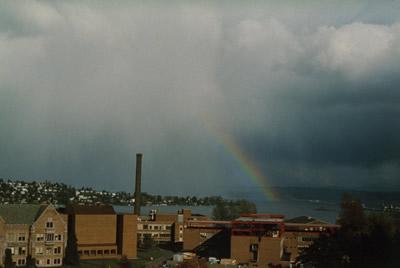This is a photograph of cumulus clouds.
Click on image for full size
Courtesy of Carlye Calvin
Cumulus
Cumulus (weather symbol - Cu) clouds belong to the Clouds with Vertical Growth
group. They are puffy white or light gray clouds that look like floating cotton
balls. Cumulus clouds have sharp outlines and a flat base. Cumulus clouds
generally have a lower cloud deck of 1000m and a width of 1km.
Cumulus clouds can be associated with good or bad weather. Cumulus humilis
clouds generally show up on a warm summer day and are associated with fair
weather. These clouds have only slight vertical growth and they are detached
with lots of blue sky in between. Cumulus congestus clouds are usually
associated with bad weather. These clouds grow to great heights and usually
become cumulonimbus clouds. Their tops look
like cauliflower heads and indicate that light to heavy showers can occur.
Here's a tip on how to know if you see a cumulus cloud in the sky. Cumulus cloud cells (the individual puffs of clouds) are about the size of your fist or larger when you hold up your hand at arm's length to look at the cloud.
You might also be interested in:

Clouds with vertical growth include cumulus and cumulonimbus clouds. These clouds grow high up into the atmosphere rather than spreading across the sky. They span all levels of the troposphere and can
...more
Cumulus clouds can be associated with good or bad weather. Cumulus humilis clouds are common in the summer and are associated with fair weather. They are usually widely spaced in the sky, have a flat base
...more
Cumulus clouds can be associated with good or bad weather. Cumulus congestus clouds, also called towering cumulus, are in the last stage of development before becoming cumulonimbus clouds. The tops of
...more
Nimbostratus (weather symbol - Ns) clouds are composed of water droplets and belong to the Low Cloud (surface to 2000m up) group. They are dark gray with a ragged base. Nimbostratus clouds are associated
...more
If you were fortunate to spend time recently in the Maldives, a collection of tropical islands in the central Indian Ocean, you may have seen a collection of tiny aircraft buzzing overhead. With a wingspan
...more
Weather fronts can cause clouds to form. Fronts occur when two large masses of air collide at the Earth's surface. Warm fronts produce clouds when warm air replaces cold air by sliding above it. Many different
...more
On November 1st I flew onboard the Twin Otter aircraft. This day was an incredibly interesting day to fly. Not only did we fly through a large stratocumulus cloud but we also flew through lots of smaller
...more














